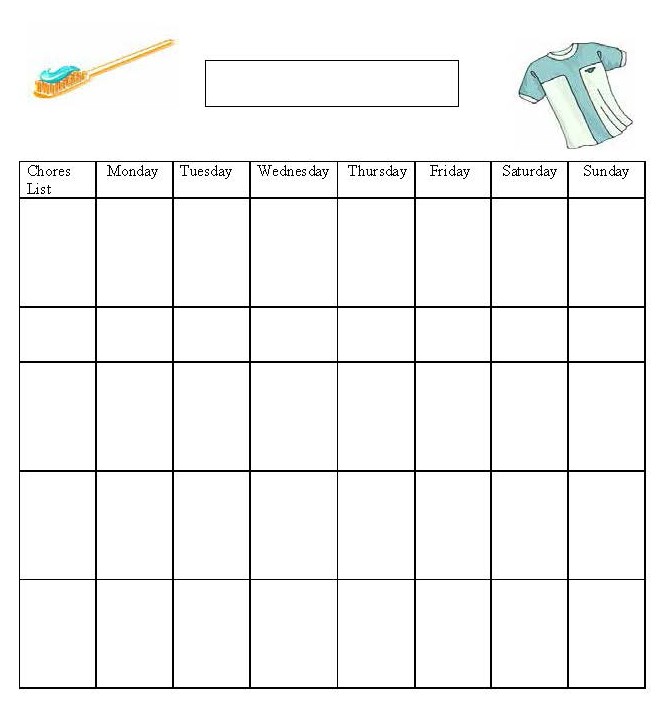TOPIC:
Responsibilities and Recognition — developing a sense of responsibility and self-efficacy
RESOURCES NEEDED:
Blank paper, printer, stickers (optional)
LEARNING OPPORTUNITY:
The concepts of work and responsibility will be important in a child’s life. Some work is done as a responsibility—e.g. chores at home. Some work is done to earn income—such as a job. And some work can be done as a “volunteer” to help others or join a cause to do something to try and make things better. Developing a Chore Chart can be a great way to have this kind of discussion—and can also help to discuss and organize your child’s responsibilities at home.
The topic of “allowance” often comes up when talking about chores and responsibilities at home. This is a debatable topic and there are links to a variety of articles at the end that you can reference as you decide how you would like to handle things.
THE ACTIVITY:
Talk with your child about all the chores that have to be done around the house. Decide on the list of chores that will be the responsibility of your child. Discuss why the chore is important.
It is good to try and develop within your child an appreciation of the value of all work.
Put the list of responsibilities in the form of a “Chores Chart” like that shown. Open the link to the Chores List below and print a copy. Put the child’s name in the box at the top of the chart, list the chores in the left hand column, and mount it on the fridge or wall where it can readily be seen. You or your child may then put a check mark in the box each day a chore is done or put a sticker in the box when it is completed. Some suitable chores for this age group are:
- Hang up coat
- Put shoes away
- Put toys away
- Make their bed with minimal parental help
- Bring their things from the car to the house
- Brush teeth
- Comb hair
- Choose the day’s outfit and get dressed with minimal parental help
- Get backpack ready for school
Recognition for completing tasks and responsibilities will be helpful—which can be praise, or a treat of some kind, or simply the assignment of the sticker to recognize a job well done. You may wish to involve your child in deciding what the recognition will be—and also the consequence if chores are not done.
TIPS:
Review the Chores Chart over time and change the list of tasks and responsibilities as your child can take on more responsibility. If your child doesn’t complete one or more of their chores, try to avoid making this a negative thing. If they have not done a chore, remind them with a single word, e.g. “Teeth,” “Bed,” “Shoes,” etc. Simple, short reminders should hopefully work and keep things positive.
REFERENCE:
This activity is based upon the following article that appeared on the “About.com” website:“Kid Chores Teach Responsibility, Family Involvement: Don’t Let Chore List Become Dispute”; by Robin McClure. http://childcare.about.com/od/generaladvice/a/kidchores.htm
BOOKS AND ARTICLES WRITTEN ABOUT ALLOWANCES:
Websites and links change all the time but, if you “search” for the following articles or books with the author’s name, they should be easy to locate and reference.
- Kids’ allowance tips by Neale S. Godfrey
- Allowances are more than child’s play by Bryan Borzykowski
- Mom, Can I Have… – Teaching kids about money by Gail Vaz-Oxlade
- Teaching kids to value money by Gail Vaz-Oxlade
- Looking for the perfect allowance system by Dianne Nice
- Kids’ Money for Parents – Allowance Statistics—on the Kids Money website
- 5 Money Lessons Allowances Teach Kids by Tamar Satov
- Allowance 101 by Kris Wallace on BMO’s Smart Steps for Parents website
- Is it allowance time by Kris Wallace on BMO’s Smart Steps for Parents website
- Children’s Allowance: Good or Bad by Olga Goncalves Costa Olga
- Allowance: Tips on Giving Children Allowance by Christie Laverty
- Allowances by Amanda Bloye
- Give ‘em an Allowance! by David McCurrach
- Parents See Allowances As An Educational Tool by Amy Nathan
- The Kids’ Allowance Book by Amy Nathan
- Money Management Starts with Allowance by Caryl Horan
- Piggy bank to Credit Card by Linda Barbanel
- Young Investor Parent’s Guide On Allowances by Liberty Financial
- How to Raise Money-Smart Kids by Elizabeth S. Lewin and Bernard Ryan Jr.
- Should allowance be tied to chores? by Jim Yih
- Incorporate your money values into your allowance program by Jim Yih
- Also, search for writings by Suze Orman on the topic of allowances





